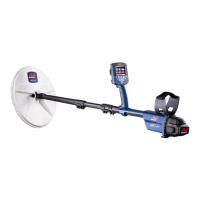Detecting Basics
32
Detecting Basics
Holding the Detector
Thread your arm through the
armrest and strap. Grasp the handle
of the detector and rest your
forearm in the armrest.
The correct position of the armrest
should allow you to comfortably
grip the handle. Your elbow should
sit just above the back of the
armrest and the detector should
feel like an extension of your
forearm.
Adjust the Length of the Shafts
The mid shaft can be adjusted to any length between
fully extended and fully retracted. Adjust the mid shaft to
the correct length and secure the cam lock on the upper
shaft to lock the shaft position.
A correct shaft length will allow you to swing the coil over
the ground without uncomfortably stretching or stooping.
If the coil is too far from your body it will be difficult to
balance and manoeuvre while detecting. If the coil is too
close to your body it may detect your digging tools or
any other metal which you are carrying, causing confusing
sounds.
Adjust the Angle of the Coil
Loosen the bolts that connect the lower shaft to the coil.
Note that these bolts are retained and are not designed
to be disassembled by the user. The bolts should be loose
enough to allow the coil to be moved for adjustment, but
tight enough that the coil can hold its position.
While holding the detector as if detecting, lightly press
the coil to the ground until it sits flat/parallel with the
ground. The coil should remain parallel when lifting to the
sweep height, approximately one inch (25 mm) above the
ground.
Tighten the bolts just enough to hold its position.
Sweeping the Coil
CAUtIoN
Sweeping the coil incorrectly can miss targets
or generate false signals.
You will obtain the best performance when the coil is
swept close and parallel to the ground at all times. This
will increase detection depth and improve the response
to small objects. Avoid excessive brushing of the coil on
the ground.
Though the coil assembly is rigid and durable, sudden
jolts or bangs can cause random signals, as well as
excessive wear and tear. Careful sweeping will ensure the
coil performs to an optimum level at all times.
Practice sweeping the coil over the ground in a side-to-
side motion while slowly walking forward at the end of
each sweep. Slightly overlap the previous sweep to ensure
full ground coverage. An average sweep speed is four
seconds from left to right to left.
If you are getting signals from a visibly clear patch of
ground, there could be buried metal objects. Try finding
another area to practice.
Types of Targets
Metal objects are referred to as targets. Targets are
comprised of ferrous and nonferrous metals. Ferrous
metals are those containing iron; such as steel, nails and
some types of coins. Nonferrous metals are those which
are not magnetic, such as gold, silver, copper, bronze and
aluminum.
You may wish to find a range of both ferrous and
nonferrous targets.
Examples of common targets:
• Desired high ferrous target – war relic

